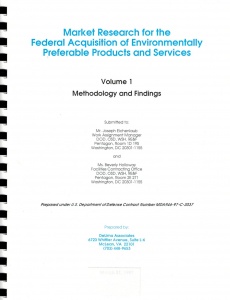Environmentally Preferable Products Database – Renovation of The Pentagon.
Purpose
The recent renovation of the Pentagon required the building contractor to use environmentally preferable construction materials and practice. Environmentally Preferable Products (EPP) are “products and services [that] have a lesser or reduced effect on human health and the environment when compared to other products and services that serve the same purpose.” This comparison may consider raw materials acquisition, production, manufacturing, packaging and distribution. The Department of Defense hired DeLima Associates to identify environmentally preferable products and suppliers for each of 178 types of building components and systems at the Pentagon building and create a database of EPP for use by the renovation contractor.
Approach
DeLima Associates’ primary goal was to identify environmentally preferable products that met specific criteria specified by the U.S. Environmental Protection Agency (EPA). Using building magazines, catalogs, directories, and internet sites that emphasize environmental issues, DeLima Associates identified at least three suppliers offering products with enhanced environmental features for each product on DOD’s initial list of 178 conventional building products. It then broke down DOD’s initial product list into 44 product categories and developed a market survey to gather environmental information for each category. These surveys were mailed to more than 200 suppliers. The surveys were designed to help DOD determine which environmental attributes to include for each product that would be described in the construction specifications. They included general questions about material acquisition, manufacturing and fabrication, construction, product use, maintenance, recyclability and disposal, packaging, and transportation issues. Additional product-specific questions elicited detailed information on each product category. Questions regarding forestry management practice, for example, were included in the surveys sent to wood product manufacturers. Sealant manufacturers received different environmentally oriented questions about VOC and toxic material content. DeLima Associates’ effort produced ten, 3-inch-thick binders of product information, including Material Safety Data Sheets, product literature, and survey answers. DOD incorporated DeLima Associates’ findings into the product specifications section of the RFP used to solicit potential contractors. Traditionally, DOD inserts existing product specifications from previous RFPs when preparing a new one. Though the traditional approach saves time and helps ensure consistent performance, it limits the opportunity to introduce innovative products and processes, including products and services with improved environmental performance. For the ID/IQ construction RFP, DOD modified 75 percent of the more than 400 product specifications to include specific environmental features.
The following examples highlight a few of the beneficial environmental attributes introduced into the product specifications:
Packaging of Materials: To the extent possible, all packaging, labeling, and instruction materials shall be made from recovered or biodegradable materials with the highest percentage of postconsumer materials possible. Contractor shall give preference to those manufacturers that minimize packaging.
Plumbing Fixtures: All fixtures shall be water conserving, in accordance with the National Standard Plumbing Code.
Masonry:Reinforcingsteelrodsandbarsshallcontainaminimumrecycled steel content of 60 percent. Concrete masonry units shall contain a minimum recycled materials content of 50 percent.
Building Insulation: Extruded polystyrene insulation shall not be manufac- tured with ozone depleting blowing agents and shall maximize use of recycled material.
Although DOD added environmental attributes to its specifications, it did not modify its traditional performance requirements. All of the specified products are required to meet DOD’s traditional criteria, including that they:
- Meet consumer performance requirements.
- Meet industry standards, local codes, and all pertinent regulations.
- Are price competitive in the marketplace.

